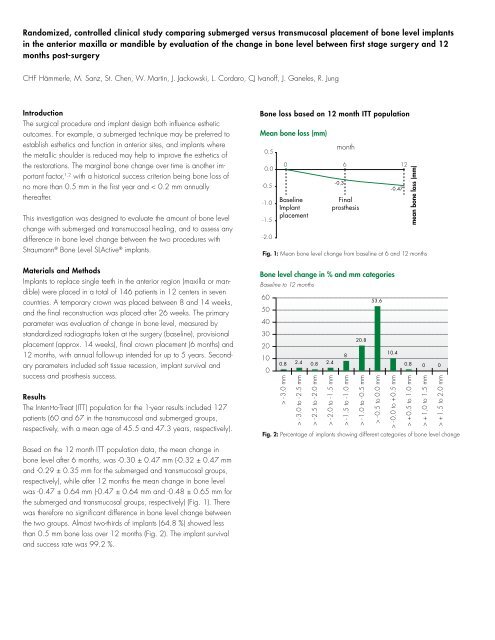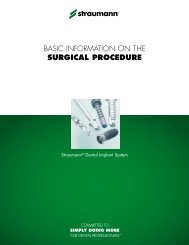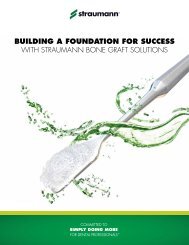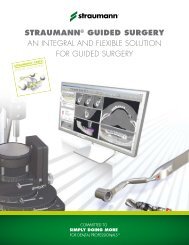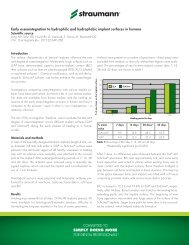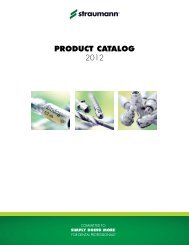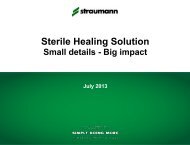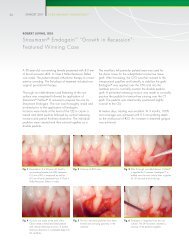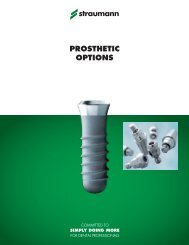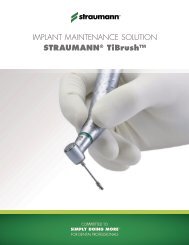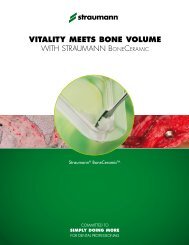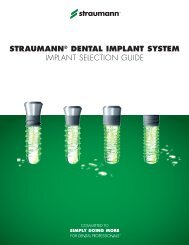BONE LEVEL IMPLANT SCIENTIFIC OVERVIEW - Straumann
BONE LEVEL IMPLANT SCIENTIFIC OVERVIEW - Straumann
BONE LEVEL IMPLANT SCIENTIFIC OVERVIEW - Straumann
Create successful ePaper yourself
Turn your PDF publications into a flip-book with our unique Google optimized e-Paper software.
Randomized, controlled clinical study comparing submerged versus transmucosal placement of bone level implants<br />
in the anterior maxilla or mandible by evaluation of the change in bone level between first stage surgery and 12<br />
months post-surgery<br />
CHF Hämmerle, M. Sanz, St. Chen, W. Martin, J. Jackowski, L. Cordaro, CJ Ivanoff, J. Ganeles, R. Jung<br />
Introduction<br />
The surgical procedure and implant design both influence esthetic<br />
outcomes. For example, a submerged technique may be preferred to<br />
establish esthetics and function in anterior sites, and implants where<br />
the metallic shoulder is reduced may help to improve the esthetics of<br />
the restorations. The marginal bone change over time is another important<br />
factor, 1,2 with a historical success criterion being bone loss of<br />
no more than 0.5 mm in the first year and < 0.2 mm annually<br />
thereafter.<br />
This investigation was designed to evaluate the amount of bone level<br />
change with submerged and transmucosal healing, and to assess any<br />
difference in bone level change between the two procedures with<br />
<strong>Straumann</strong> ® Bone Level SLActive ® implants.<br />
Materials and Methods<br />
Implants to replace single teeth in the anterior region (maxilla or mandible)<br />
were placed in a total of 146 patients in 12 centers in seven<br />
countries. A temporary crown was placed between 8 and 14 weeks,<br />
and the final reconstruction was placed after 26 weeks. The primary<br />
parameter was evaluation of change in bone level, measured by<br />
standardized radiographs taken at the surgery (baseline), provisional<br />
placement (approx. 14 weeks), final crown placement (6 months) and<br />
12 months, with annual follow-up intended for up to 5 years. Secondary<br />
parameters included soft tissue recession, implant survival and<br />
success and prosthesis success.<br />
Results<br />
The Intent-to-Treat (ITT) population for the 1-year results included 127<br />
patients (60 and 67 in the transmucosal and submerged groups,<br />
respectively, with a mean age of 45.5 and 47.3 years, respectively).<br />
Bone loss based on 12 month ITT population<br />
Mean bone loss (mm)<br />
0.5<br />
0.0<br />
-0.5<br />
-1.0<br />
-1.5<br />
-2.0<br />
Fig. 1: Mean bone level change from baseline at 6 and 12 months<br />
60<br />
50<br />
40<br />
30<br />
20<br />
10<br />
0<br />
0<br />
Baseline<br />
Implant<br />
placement<br />
- 0.3<br />
6 12<br />
Final<br />
prosthesis<br />
Bone level change in % and mm categories<br />
Baseline to 12 months<br />
0.8 2.4 0.8 2.4<br />
> - 3.0 mm<br />
> - 3.0 to - 2.5 mm<br />
> - 2.5 to - 2.0 mm<br />
> - 2.0 to - 1.5 mm<br />
month<br />
8<br />
> - 1.5 to - 1.0 mm<br />
20.8<br />
> - 1.0 to - 0.5 mm<br />
53.6<br />
- 0.47<br />
10.4<br />
Fig. 2: Percentage of implants showing different categories of bone level change<br />
> - 0.5 to 0.0 mm<br />
> - 0.0 to + 0.5 mm<br />
mean bone loss (mm)<br />
0.8 0 0<br />
> + 0.5 to 1.0 mm<br />
> + 1,0 to 1.5 mm<br />
> + 1.5 to 2.0 mm<br />
Based on the 12 month ITT population data, the mean change in<br />
bone level after 6 months, was -0.30 ± 0.47 mm (-0.32 ± 0.47 mm<br />
and -0.29 ± 0.35 mm for the submerged and transmucosal groups,<br />
respectively), while after 12 months the mean change in bone level<br />
was -0.47 ± 0.64 mm (-0.47 ± 0.64 mm and -0.48 ± 0.65 mm for<br />
the submerged and transmucosal groups, respectively) (Fig. 1). There<br />
was therefore no significant difference in bone level change between<br />
the two groups. Almost two-thirds of implants (64.8 %) showed less<br />
than 0.5 mm bone loss over 12 months (Fig. 2). The implant survival<br />
and success rate was 99.2 %.


